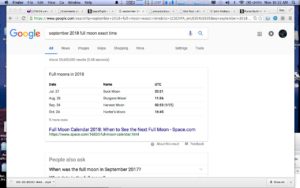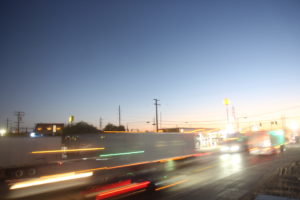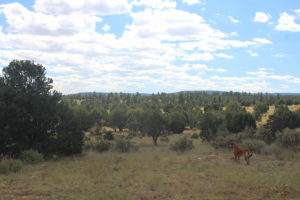Note: As I write this note on September 24th (2018) tonight will be this year’s ‘Harvest Moon,’ which means the full moon nearest to the autumnal equinox, a celestial event that already happened, a couple days ago, on Saturday the 22nd. Here’s a surprisingly accurate explanation, from Space.com:
On Sept. 22 at 9:54 p.m. EDT (0154 GMT on Sept. 23), the sun will cross the celestial equator, or an imaginary line that projects Earth’s equator into space. At this exact moment, the Northern and Southern hemispheres will receive an equal amount of sunshine, and the length of day and night will be approximately equal around the world — hence the term “equinox,” which is derived from the Latin phrase meaning “equal night.”

Exact times and names of recent full moons: ‘Harvest Moon’ is so-named because farmers could continue to reap crops under its light.
I describe the above as ‘surprisingly accurate’ for a couple, related reasons. See, I subscribe to Space.com’s notifications out of my of morbid curiosity to see what the PTB have seen fit to mis/disinform us about each day, and Space.com is a great source of science’s prevarications and blatant errors of fact and theory. As you might expect, Space.com specializes in the latest news about astronomy, cosmology (astrophysics), and space travel, and they rarely – I’m talking rarely if ever – subject us ‘masses’ to an actual truth.
But I’ll have more to say on mainstream science’s whoppers when I get around to my reviews of Who Built the Moon? and The Most Dangerous Book in the World; 9/11 as Mass Ritual, after which I’m planning on specific science-related posts.
Meanwhile, to mark this year’s Harvest moon, I did one of my ‘moving still photos,’ this one featuring both myself and the moon, at full glory. Although a day early, last night when I shot the vid, the sumbitch sure looked full. (Full moons, like equinoxes, occur at ‘moments in time,’ not ‘on days’: technically, the full moon where you are could ‘occur’ during daytime. Just FYI kinda thing.)
Allan
I’m struggling a bit with my explanation of why the two books I’ve recommended are important. Aside from fatigue from three days on the road, one problem is that I’ve been unable to get a reply from one of the authors of Who Built the Moon?, which is worrisome… But hey, hang in; I’m aiming at something worthwhile, I think.



The question “if higher life only developed on Earth because the Moon is exactly what it is and where it is” (from the excerpt on amazon) seems to be in the same league as asking what was there first, the egg or the chicken. We cannot prove if there would be life without Moon or how would life become then. It’s a rhetorical question aimed to waste our precious time with bollocks. There are more interesting questions, like why can the Moon have seemingly the same size as the Sun on some occasions, or why do all planets move on a plane around the sun, etc.
I know it’s a spoiler on Who Built the Moon but I have to say the author’s conclusion was a real let-down. Kind of a big-ass reversal of causality in the universe as I’ve know it all my life. Anything amazing that exists has to have come from the future? Sounds like Firesign Theatre grade fiction to me. Actually that’s an insult to the Firesign Theatre.
Note from Allan: I completely agree. My interest in the book is strictly in the meaning of the numbers they cite, not in their dumb ass theory.
The fake moon rock gifted to Holland brings into question the provenance of all moon rocks. Of course, the story of the fake moon rock may also be dubious.
Not so dubious when one considers the preponderance of evidence which suggests that the Moon Landings were a hoax.
All of the current theories of how the moon got created and settled into orbit around the Earth have major flaws and none of them agree with known physics.
And if we did go to the Moon, I highly doubt it was in the Apollo rockets. There has been a secret technology program going on forever- possibly from the survivors of Atlantis (and before that Mars?) who have stayed in the shadows all these years while us primitives learn to chew gum and rub our bellies at the same time.
Note: Allan pretty much agrees.
Miss the postcards from the road series – thank you Allan for your portrait-moon time lapse. Looking forward to reading what new information you have to say re the moon and the most dangerous.
Looking fwd to the book reviews before ordering
“I’m not a geologist, but…” “I’m not a nuclear physicist, but…” “I’m not a regular physicist, but…” “I’m not an astro engineer, but…” I’m not an expert on holograms, but…” “I’m not a computer engineer, but…”
…I am drowning in internet confirmation bias of whatever ridiculous horseshit I already believe. And I am gullible and ignorant through absorption of misinformation from conspiratorial jackasses that don’t know what they are talking about.
–Chris
When in doubt there is always Bill Nye the science guy…
Friend of mine sent me this fragment as part no doubt of something else….
LUNAR SAMPLE NO. 67016,4
This Apollo 16 Lunar Sample (moon rock) was collected by the Apollo 16 crew at Station 11 on the Southeast rim of Rim of North ray Crater. This rock weighs 93.5 grams.
It is a fragment of the original rock that weighed 4,262 grams, when returned to Earth.
The sample is a polymict breccia, and like all Lunar highland breccia, it is very old, older than 99,009 of all Earth surface rocks.
This rock is 3.9 billion years old. Scientific research is being conducted on the balance of this sample at NASA’s Johnson Space Centre and t other research centers in the United States and certain foreign nations under a continuing program of investigation involving lunar samples collected during the Apollo Programme.
Comment welcome!
Can rock be reliably dated? I’m not a geologist but I understand radiometric and carbon dating techniques are not without controversy. I’d also want to inspect the chain of evidence regarding any sample before basing conclusions on data purportedly generated from it (you did ask for comments!)
> Can rock be reliably dated?
Exactly the problem.
I remember a case when rocks from a vulcanic island were tested which definitely originated in the 1950’s. That dating came up with several hundred million years.
Can’t find any link at the moment, though.
Does it taste the moon?
*like the moon. *sigh*
Your friend sent a fragment of moon rock? Or a fragment of info?
more info: https://www.lpi.usra.edu/lunar/samples/atlas/compendium/67016.pdf
So you are of the”we” went there filming is real or “we” went there filming is fake? Or “we” went there in a out of public domain craft and filming is fake? Or what?